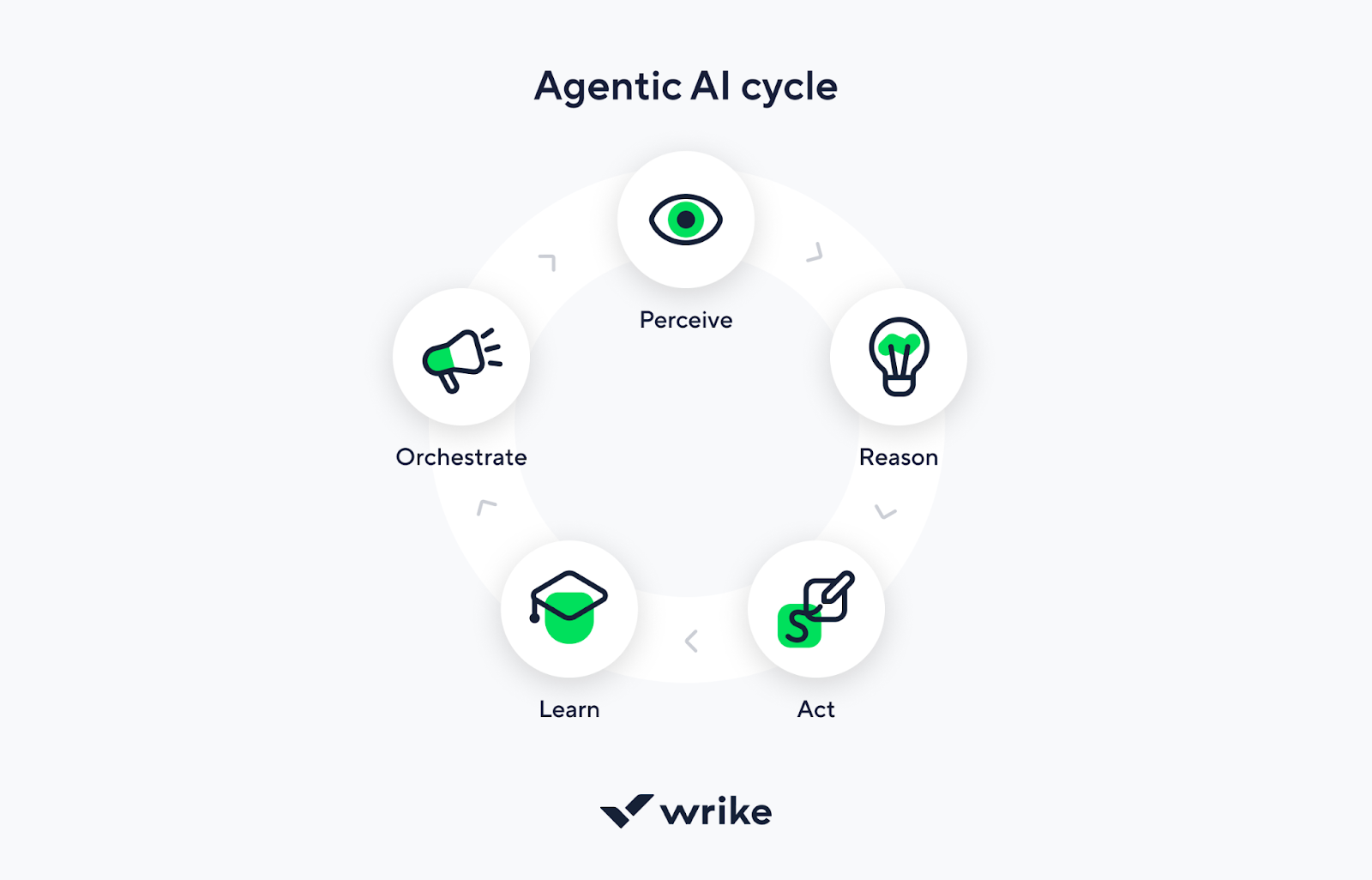Key takeaways:
- What is agentic AI? It refers to autonomous AI systems that think, decide, and act independently, enhancing efficiency and adaptability in workflows.
- How does agentic AI differ from traditional AI? Unlike traditional AI, which relies on human prompts, agentic AI operates autonomously based on predefined goals and context.
- What are the key features of agentic AI? Key features include autonomy, decision making capabilities, adaptability, natural language understanding, and collaboration abilities.
- What industries benefit from agentic AI? Industries such as healthcare, finance, retail, and customer service are leveraging agentic AI for real-time decision-making and process automation.
- What are the pros and cons of agentic AI? Pros include smarter decision making and reduced manual workload, while cons encompass high implementation costs and ethical concerns.
Picture a factory floor before the Industrial Revolution — machines clunking along in fixed lines, every task tied to a central steam engine, every move dependent on manual coordination. Then electricity arrived. Suddenly, production lines could shift. The equipment could be spread out. Work could flow faster, smarter, and with greater precision.
Agentic AI is today’s version of that turning point. But instead of powering physical machines, it fuels intelligent systems that think, decide, and act independently. It breaks workflows free from rigid processes and bottlenecks, allowing teams to move with the same agility and scale that transformed the Industrial Era centuries ago.
With agentic AI, work becomes dynamic and constantly in motion, opening the door to a new era of strategic execution.
These autonomous, decision-capable systems are redefining how people work. With the ability to process real-time data, make decisions independently, and tackle complex tasks with minimal human intervention, agentic AI systems are unlocking new levels of efficiency across industries.
What is agentic AI?
Agentic AI refers to artificial intelligence systems that can act independently and adapt to changing environments with minimal human input. Unlike traditional AI or generative AI, which creates content based on human prompts, agentic AI is designed to operate independently based on predefined inputs and outputs.
Agentic AI = AI agents working together in multi-agent systems.
These digital workers:
- Automate complex or repetitive tasks
- Process vast amounts of data
- Make data-driven decisions
- Retain natural language understanding
- Have complex reasoning skills
In short, agentic AI is purpose-built to move work forward, especially in tasks or complex workflows that demand continuous adaptation and timely, independent action.
AI agents and agentic AI systems
Unlike AI assistants, which are user-facing tools, AI agents are individual intelligent software entities designed to perform a specific task with some level of autonomy. There are many types of AI agents, each designed to address specific needs across an enterprise.
An AI agent typically:
- Perceives its environment
- Processes information
- Acts toward a defined goal
Think of an AI agent as a task-focused bot, like a customer service chatbot or scheduling assistant. It might operate independently or trigger actions based on data.
On the other hand, agentic AI systems refer to a broader architecture of multiple AI agents working together in coordinated, autonomous workflows. It includes the full cognitive cycle: perceive, reason, act, learn, and orchestrate.
For instance, in a logistics operation, one agent might detect delays at a warehouse, another could instantly reroute a shipment to avoid bottlenecks, and a third might notify the customer of the updated delivery timeline.
Key features of agentic AI
What if your AI didn’t just answer questions, but actually knew what to do next? Agentic systems are designed to thrive in fast-moving, complex environments. They give teams a strategic edge by operating independently, adapting in real time, collaborating across functions, and making intelligent decisions that move work forward.
Here’s what sets agentic AI apart:
- Autonomy: Agentic AI systems function independently and take action without needing step-by-step instructions. This independence reduces the need for constant oversight and enables faster, autonomous workflows.
- Goal-oriented: Rather than responding to isolated prompts, agentic AI works toward defined outcomes. It understands the objective, breaks it down into actionable steps, and adjusts its approach as conditions change.
- Decision-making capabilities: Agentic systems make complex decisions in real time. This allows them to resolve roadblocks, prioritize actions, and choose the best path forward.
- Adaptability: These systems improve as they go. By learning from data, outcomes, and user feedback, agentic AI adjusts its behavior and fine-tunes its decisions to get better with every interaction.
- Natural language understanding: Agentic AI can interpret and respond to human language, which allows teams to interact with systems more intuitively and improve communication.
- Tool proficiency: These systems aren’t confined to a single interface. Agentic AI can interact with other tools, platforms, and databases to gather insights and orchestrate workflows across a tech stack.
- Contextual awareness: Agentic AI grasps the bigger picture and understands how variables interact, so it can adapt its decisions based on goals and shifting conditions.
- Self-optimization: Agentic systems are built to improve over time. They monitor their own performance, identify inefficiencies, and improve continuously, optimizing outcomes without waiting for human input.
- Collaboration abilities: Agentic AI thrives in teamwork. Whether coordinating with other agents or aligning with human teams, it shares insights, distributes responsibilities, and keeps cross-functional efforts synchronized.
Together, these features make agentic AI a powerful tool for leaders aiming to transform how work flows.
Agentic AI vs. generative AI
While both are part of the AI revolution, agentic AI and generative AI serve different purposes.
- Generative AI is focused on content creation, language generation, and data synthesis. It reacts to prompts and produces outputs like text, images, or code based on learned data, and it’s rapidly being adopted across industries for use cases like marketing copy, code generation, and customer service chatbots.
- Agentic AI, by contrast, is designed for autonomous action. It doesn’t wait for a human prompt; it perceives its environment, reasons about what to do next, and takes action. These systems are goal-driven and operate independently in many cases.
How does agentic AI work?
Agentic AI works through a continuous cycle that mirrors human decision making but at machine speed. It needs a shared context to do all of those things intelligently and consistently. That’s where MCP comes in.
The Model Context Protocol (MCP) is a framework that gives agentic systems a shared understanding of objectives and evolving context. MCP acts as the connective tissue between multiple agents and the strategic goals they’re working toward.
Unlike traditional or reactive AI, agentic AI mimics human-like decision making by observing its environment, reasoning through possibilities, taking action, learning from feedback, and coordinating efforts across tasks and teams.
Here’s the full cognitive cycle:
1. Perceive
AI agents begin by perceiving their environment through real-time data intake. This can include user interactions, activity logs from enterprise systems, live updates from operational tools, and external data streams like market fluctuations or supply chain indicators.
For example, in a customer support setting, an agent might monitor incoming support tickets, website activity, and chat logs simultaneously to assess priority. Without accurate perception, even the most advanced agents cannot make informed decisions or execute effectively.
2. Reason
Some agents rely on advanced models, such as large language models (LLMs) and retrieval-augmented generation (RAG), to interpret the data they’ve gathered.
For example, an agent analyzing market performance might retrieve relevant reports and news updates, synthesize that information, and assess whether to trigger a pricing change or supply chain adjustment.
These reasoning capabilities allow agents to simulate different outcomes and make context-aware decisions aligned with business objectives. This step ensures the AI doesn’t just act on isolated inputs but responds intelligently to complex or evolving environments.
3. Act
Once a plan is formed, agents take action. An agent might initiate a procurement order, reassign project tasks based on shifting deadlines, or launch a marketing campaign across multiple channels.
In customer service, agents could update ticket statuses, send responses to users, and escalate critical issues automatically. Agents use real-time data to stay on track and make informed decisions.
4. Learn
Agents continuously learn by observing the results of their actions and processing additional real-time data.
For instance, a customer support agent might analyze the success of its responses, compare them against user satisfaction scores, and adjust its tone or escalation logic accordingly. In a supply chain setting, an agent might refine its delivery estimates or reorder points based on historical performance and new shipping trends.
Over time, this feedback loop enhances the agent’s ability to make smarter decisions and adjust its behavior to fit new scenarios.
5. Orchestrate
In complex workflows, multiple AI agents operate in tandem to complete multistep tasks. One agent might handle data collection while another evaluates priorities or executes decisions based on incoming insights.
This orchestration involves structured delegation of responsibilities, real-time communication between agents, and continuous tracking of progress against goals.
For example, in a product launch, one agent might manage creative asset approvals, another coordinates vendor timelines, and a third tracks budget thresholds — all synchronized through a shared context and goal.
Agentic AI examples across industries
From factory floors to financial hubs, agentic AI is stepping into the driver’s seat, reshaping how industries operate in real time. First, we saw the rise of autonomous vehicles, then robotic process automation, and now dynamic AI agents.
Agentic AI is already saving time at work by automating complex processes and improving responsiveness in real time. Because of this, it’s changing how many industries work.
Healthcare
AI agents support healthcare teams by interpreting patient data, flagging anomalies, and helping prioritize diagnostic tests. They can also recommend treatment paths based on historical outcomes and evolving clinical guidelines.
For example, Ambience Healthcare is building intelligent agents that analyze visit notes to automatically deliver follow-up instructions, remind patients about medications, and prompt them to schedule future appointments.
Finance
Financial institutions use agentic AI to execute trades across multiple markets, flag suspicious activity for further investigation, and automatically generate regulatory reports. These agents can also adjust investment strategies in response to real-time market data, which helps firms stay competitive and compliant without manual intervention.
Retail
Retailers from Amazon to Sephora have deployed autonomous agents to personalize shopping experiences based on customer behavior. They anticipate demand through inventory forecasting and respond to inquiries with context-aware support.
These systems continuously analyze purchasing patterns and supply trends, allowing for proactive inventory adjustments and real-time promotional targeting.
Customer service
Agentic chatbots handle complex customer inquiries, triage issues based on urgency and context, and route tickets to the appropriate teams to ensure quick, accurate support.
For example, Walmart implemented a retail-specialized LLM so AI agents could handle tasks like personalized recommendations and product comparisons all through a conversational chatbot experience.
AI agents for project management take on responsibilities like adjusting timelines, reassigning tasks, and removing blockers as they arise. These systems help teams stay on top of shifting priorities by quickly adjusting resources and keeping everyone in the loop on project progress.
AI project management tools are also changing how project management officers (PMOs) work.Pros and cons of agentic AI
While agentic AI presents clear advantages for organizations seeking speed and real-time decision making, it also introduces important challenges that must be addressed.
| Pros | Cons |
| Boosts decision making with real-time data | High implementation costs |
| Reduces manual workload | Potential for misuse |
| Enables 24/7 operations | Ethical and data privacy concerns |
| Scales easily across teams and functions | Risk of overdependence on automation |
| Encourages innovation and agility | Can replicate human bias or errors |
Pros of agentic AI
These systems are built to drive strategic execution and free teams from the drag of everyday inefficiencies. Agentic AI offers a range of advantages that make it a valuable asset for organizations aiming to boost efficiency and improve strategic execution.
- Smarter decision making: Agentic AI processes complex datasets in real time to surface insights that help teams move quickly and confidently.
- Reduces manual workload: By automating repetitive tasks, agentic AI clears the way for teams to focus on more impactful work.
- Adapts on the fly: These systems are built to respond to change by learning from new data and adjusting in real time without needing a reset.
- Easy to scale: Whether you’re rolling it out across departments or teams, agentic AI scales without piling on extra complexity.
- Keeps things moving: With autonomous decision making and built-in optimization, these tools help keep projects on track — even when things shift midstream.
Cons of agentic AI
Like any powerful tool, agentic AI has its trade-offs and has a set of crucial drawbacks leaders must address.
- High implementation costs: Implementing and maintaining agentic systems can be resource-intensive, especially for teams without a solid tech foundation.
- Ethical and privacy concerns: In industries like healthcare and finance, the stakes are high. AI needs to operate within strict boundaries to protect user data and ensure fairness.
- Risk of misuse: Without clear rules, these systems can be misused by people, or even violate legal or organizational norms.
- Too much automation: When AI handles too much, teams may start to lean too heavily on it, potentially losing the nuance of human judgment.
- Bias in, bias out: If your training data isn’t clean or representative, agentic AI can reinforce, or even amplify, systemic issues.
Some companies are adopting AI ethics policies that emphasize transparency and accountability to ease concerns about privacy and security.
The future of work is agentic
Remember when “smart tools” meant a calendar that could send reminders? We’ve come a long way.
Now we’ve got AI that can reassign tasks, flag risks, and keep projects moving while you’re in back-to-back meetings. That leap from passive tools to proactive teammates is exactly where Wrike is leading the charge.
Wrike’s new MCP Server and intelligent workflows position it at the forefront of this shift. By providing teams with real-time visibility, adaptable AI orchestration, and seamless collaboration, Wrike makes AI more accessible and effective for enterprises and project management offices.
As work gets faster and more fragmented, the teams that win will be the ones that can use AI with purpose. Agentic AI makes that possible, and Wrike makes it practical to implement.
FAQs
Is agentic AI safe and secure for enterprise use?
Yes, agentic AI can be a secure and reliable asset for enterprise workflows. It operates within defined guardrails, with transparent decision logic, human-in-the-loop controls, and customizable permissions.
What tools support agentic AI today?
Agentic AI is still emerging, but leading platforms are already building toward it. Many companies have adopted agentic workflows by combining automation, contextual task intelligence, and structured planning frameworks.
Can agentic AI replace human decision makers?
Agentic AI is built to enhance, not replace, human leadership. These systems excel at automating routine decision paths and adapting to real-time input, but they still rely on humans to set high-level objectives and oversee outcomes.
How will agentic AI change the future of business?
Agentic AI will transform how work gets done by shifting systems from reactive automation to proactive execution. For businesses, this means reduced operational friction, faster decision making, and the ability to scale strategic execution without adding headcount.
What are the core technologies powering agentic AI?
Agentic AI relies on a stack of emerging technologies, including large language models (LLMs), autonomous agents and planners, context engines and memory architectures, Model Context Protocol (MCP), and APIs and orchestration layers.
How ready are we for agentic AI?
Most organizations are in the early stages of adopting agentic AI, but the foundational elements are already in place. Enterprises that have invested in intelligent automation and scalable platforms are better positioned to implement agentic systems.
What’s the difference between adaptive AI and agentic AI?
Adaptive AI adjusts its behavior based on patterns and new data, but it still reacts within predefined boundaries. Meanwhile, agentic AI has the autonomy to make decisions, pursue objectives, and change its course of action without waiting for human input.
What’s the difference between AIOps and agentic AI?
AIOps (Artificial Intelligence for IT Operations) uses machine learning to monitor and optimize IT systems. It’s reactive, focusing on detecting anomalies and improving system performance. Agentic AI drives execution across business processes, including planning, operations, and strategy.
What’s the difference between AGI and agentic AI?
AGI is theoretical and aims to mimic human intelligence across any task. Agentic AI is real, focused, and designed to autonomously complete specific business goals like automating workflows or managing operations.



